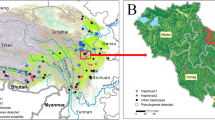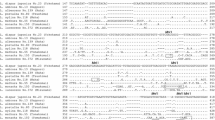Abstract
In contrast to northern hemisphere species, Australia’s Armillaria species have high variation in the rDNA Internal Transcribed Spacer (ITS) region. Isolates of the five different Australian species, five species from south-eastern Australia and one, A. luteobubalina, from Western Australia had distinct ITS sequences and PCR-RFLP profiles. Phylogenetic analyses grouped A. hinnulea away from the other Australian Armillaria species and with the seven northern hemisphere species. The 28 ITS sequences from A. luteobubalina isolates, 27 from Western Australia, gave rise to four distinct polymorphic groups. This ITS variation was not related to geographical locality, host species or mating phenotype.
Similar content being viewed by others
References
Adams DH (1974) Identification of clones of Armillaria mellea in young-growth ponderosa pine. Northwest Science 48, 21–28.
Anderson JB, Bailey SS, Pukkila PJ (1989) Variation in ribosomal DNA among biological species of Armillaria, a genus of root-infecting fungi. Evolution 43, 1652–1662.
Anderson JB, Stasovski E (1992) Molecular phylogeny of Northern Hemisphere species of Armillaria. Mycologia 84, 506–516.
Agustian A, Mohammed C, Guillaumin JJ, Botton B (1994) Discrimination of some African Armillaria species by isozyme electrophoretic analysis. New Phytologist 128, 135–143.
Banik MT, Volk TJ, Burdsall HH Jr (1996) Armillaria species of the Olympic Peninsula of Washington state, including confirmation of North American biological species XI. Mycologia 88, 492–496.
Chillali M, Idder-Ighili H, Guillaumin JJ, Mohammed C, Lung-Escarment B, Botton B. (1998a) Variation in the ITS and IGS regions of ribosomal DNA among the biological species of European Armillaria. Mycological Research 102, 533–540.
Chillali M, Wipf D, Guillaumin JJ, Mohammed C, Botton B (1998b) Delineation of the European Armillaria species based on the sequences of the internal transcribed spacer (ITS) of ribosomal DNA. New Phytologist 138, 553–561.
Coetzee MPA, Wingfield BD, Harrington TC, Dalevi D, Coutinho TA, Wingfield MJ (2000) Geographical diversity of Armillaria mellea s. s. based on phylogenetic analysis. Mycologia 92, 105–113.
Coetzee MPA, Wingfield BD, Bloomer P, Ridley GS, Kile GA, Wingfield MJ (2001) Phylogenetic relationships of Australia and New Zealand Armillaria species. Mycologia 93, 887–896.
Dunne CP, Tommerup IC, Shearer BL, Hardy GEStJ (1999) Pseudohomothallism in Armillaria luteobubalina. In ‘Proceedings from the 12th biennial Australian Plant Pathology Society Conference’, pp. 161, Canberra 1999.
Falk SP, Parbery DG (1995) Armillaria luteobubalina population structure in horticultural plantings in Victoria, Australia. Mycological Research 99, 210–220.
Felsenstein J (1993) PHYLIP (Phylogeny Inference Package), version 3.5. Department of Genetics, University of Washington, Seattle.
Glen M, Tommerup IC, Bougher NL, O’Brien PA (2001) Specificity, sensitivity and discrimination of primers for PCR-RFLP of larger basidiomycetes and their applicability to identification of ectomycorrhizal fungi in Eucalyptus forests and plantations. Mycological Research 105, 138–149.
Guillaumin JJ (1986) Contribution a l’etude des Armillaires phytopathogenes en particulier du groups Mellea: cycle caryologique, notion d’espece, role biologique des especes. These, Doctorat es Science Universite Claude-Bernard, pp. 270, Lyon, France.
Guillaumin JJ, Anderson JB, Korhonen K (1991) Life Cycle, Interfertility and Biological species. In ‘Armillaria Root Disease’ (Eds CG Shaw and GA Kile) pp. 10–20 (Forest Service, United States Department of Agriculture, Washington, D.C.)
Guillaumin JJ, Anderson JB, Legrand P, Ghahari S, Berthelay S (1996) A comparison of different methods for the identification of genets of Armillaria spp. New Phytologist 133, 333–343.
Harrington TC, Wingfield BD (1995) A PCR-based identification method for species of Armillaria. Mycologia 87, 280–288.
Higgins DG, Bleasby AJ, Fuchs R (1992) Improved software for multiple sequence alignment. Cabios 8, 189–191.
Hopper SD, Harvey MS, Chappill JA, Main AR, Main BY (1996) The Western Australian biota as Gondwanan heritage — a review. In ‘Gondwanan Heritage: Past, Present and Future of the Western Australian Biota’ (Eds SD Hopper, JA Chappill, MS Harvey and AS George), pp. 1–46 (Surrey Beatty & Sons: Chipping Norton)
Kile GA (1983) Identification of genotypes and the clonal development of Armillaria luteobubalina Watling & Kile in eucalypt forests. Australian Journal of Botany 31, 657–671.
Kile GA, McDonald GI, Byler JW (1991) Ecology and disease in natural forests. In ‘Armillaria Root Disease’ (Eds CG Shaw and GA Kile) pp. 102–121 (Forest Service, United States Department of Agriculture, Washington, D.C.)
Kile GA, Watling R (1981) An expanded concept of Armillaria luteobubalina. Transaction s of the British Mycological Society 11, 75–83.
Kile GA, Watling R (1983) Armillaria species from south-eastern Australia. Transactions of the British Mycological Society 81, 129–140.
Kile GA, Watling R (1988) Identification and occurrence of Australian Armillaria species, including A. pallidula sp. nov. and comparative studies between them and non-Australian tropical and Indian Armillaria. Transactions of the British Mycological Society 91, 305–315.
Korhonen K (1978) Interfertility and clonal size in the Armillaria complex. Karstenia 18, 31–42.
Morrison DJ, Thomson AJ, Chu D, Peet FG, Sahota TS (1985) Isozyme patterns of Armillaria intersterility groups occurring in British Columbia. Canadian Journal of Microbiology 31, 651–653.
Peabody RB, Peabody DC, Sicard KM (2000) A genetic mosaic in the fruiting stage of Armillaria gallica. Fungal Genetics and Biology 29, 72–80.
Pearce MH, Malajczuk N, Kile GA (1986) The occurrence and effects of Armillaria luteobubalina in the karri (Eucalyptus diversicolor F. Muell.) forests of Western Australia. Australian Forest Research 16, 243–259.
Podger FD, Kile GA, Watling R, Fryer J (1978) Spread and effects of Armillaria luteobubalina sp nov. in an Australian Eucalyptus regnans plantation. Transactions of the British Mycological Society 71, 77–87.
Purnell H (1959) ‘Collar rot’, or ‘dead eye’ of eucalypt species. Victoria Forests Commission, Technical Paper. No. 2, pp. 12–15.
Raeder U, Broda P (1985) Rapid preparation of DNA from filamentous fungi. Letters of Applied Microbiology 1, 17–20.
Schultze S, Bahnweg G, Moller EM, Sanderman H Jr (1997) Identification of the genus Armillaria by specific amplification of an rDNA-ITS fragment and evaluation of genetic variation within A. ostoyae by rDNA-RFLP and RAPD analysis. European Journal of Pathology 27, 225–239.
Schultze S, Bahnweg G (1998) Identification of the genus Armillaria (Fr.:Fr.) Staude and Heterobasidion annosum (Fr.) Bref. in ‘Norway spruce (Picea abies Karst.) and determination of clonal distribution of A. ostoyae genotypes by molecular methods’. Forstwissenschaftliches Centralblatt 177, 98–114.
Shaw CG, Loopstra EM (1988) Identification and pathogenicity of some Alaskan isolates of Armillaria. Phytopathology 78, 971–974.
Shearer BL (1994) The major plant pathogens occurring in ecosystems of south-western Australia. Journal of the Royal Society of Western Australia 77, 133–122.
Shearer BL, Byrne A, Dillon M, Buehig R (1997a) Distribution of Armillaria luteobubalina and its impact on community diversity and structure in Eucalyptus wandoo woodland of southern Western Australia. Australian Journal of Botany 45, 151–165.
Shearer BL, Crane CE, Fairman RG, Grant MJ (1997b) Occurrence of Armillaria luteobubalina and pathogen-mediated changes in coastal dune vegetation of south-western Australia. Australian Journal of Botany 45, 905–917.
Shearer BL, Crane CE, Fairman RG, Grant MJ (1998) Susceptibility of plant species in coastal dune vegetation of south-western Australia to killing by Armillaria luteobubalina. Australian Journal of Botany 46, 321–334.
Smith-White JL, Summerell BA, Burgess LW (2002) Molecular detection and differentiation of Australian Armillaria species. Australasian Plant Pathology 31, 75–79.
Terashima K, Kawashima Y, Cha JY, Miura K (1998) Identification of Armillaria species from Hokkaido by analysis of the Intergenic spacer (IGS) region of ribosomal DNA using PCR-RFLP. Mycoscience 39, 179–183.
Verge P, Delvallee I, Dumas C (1987) Rapid assessment of microscope and pollen development stage in wheat and maize using DAPI and membrane permeabilization. Stain Technology 62, 299–304.
Volk TJ, Burdsall HH Jr, Banik MT (1996) Armillaria nabsnona, a new species from western North America. Mycologia 88, 484–491.
White TJ, Bruns T, Lee S, Taylor J (1990) Amplification and direct sequencing of fungal ribosomal RNA genes for phylogenetics. In ‘PCR protocols: a guide to methods and applications’ (Eds Innis MA, Gelfand DH, Sninsky JJ and White TJ), pp. 315–322 (Academie Press: San Diego)
Author information
Authors and Affiliations
Corresponding author
Rights and permissions
About this article
Cite this article
Dunne, C.P., Glen, M., Tommerup, I.C. et al. Sequence variation in the rDNA ITS of Australian Armillaria species and intra-specific variation in A. luteobubalina . Australasian Plant Pathology 31, 241–251 (2002). https://doi.org/10.1071/AP02015
Received:
Accepted:
Issue Date:
DOI: https://doi.org/10.1071/AP02015




